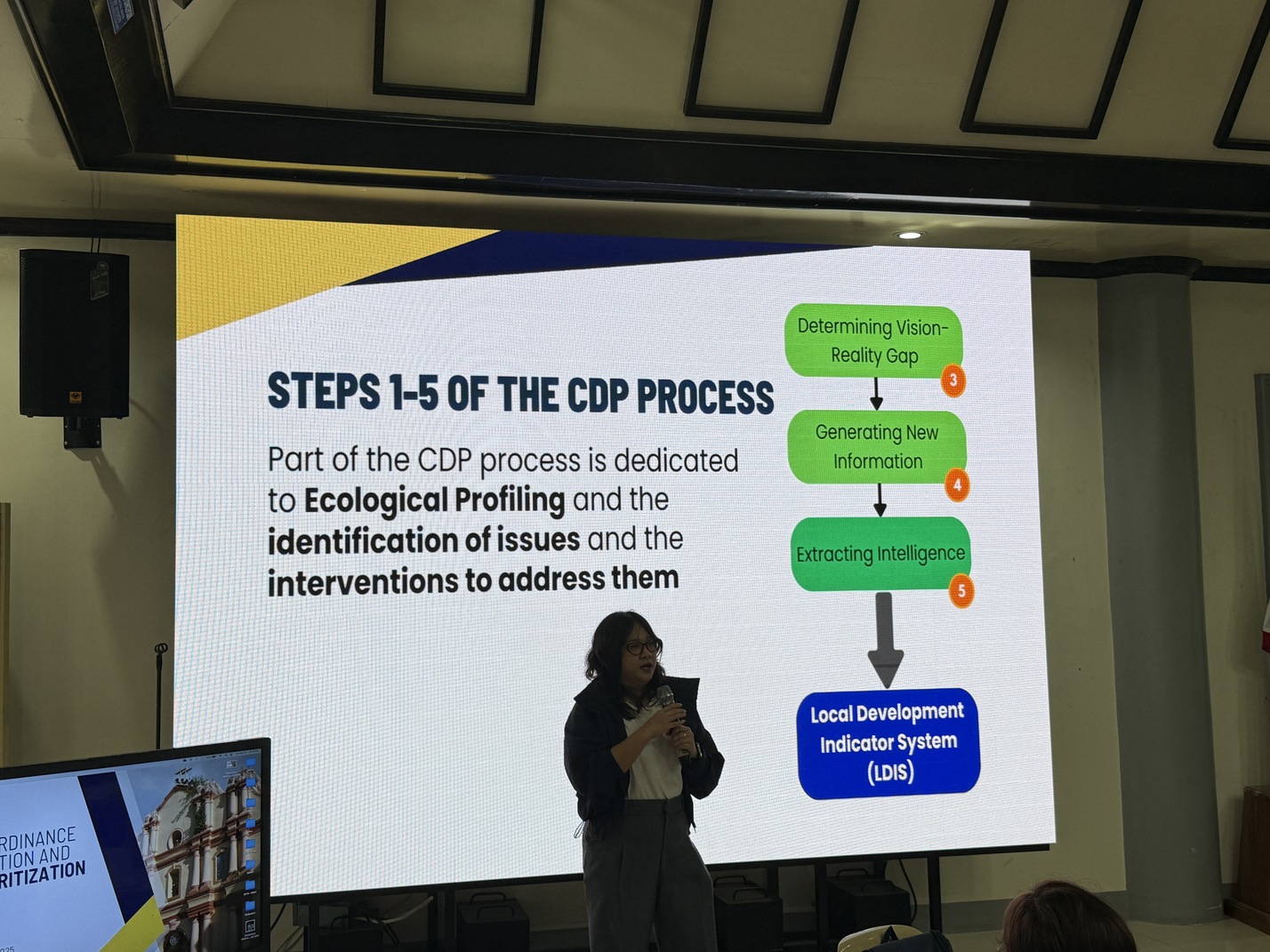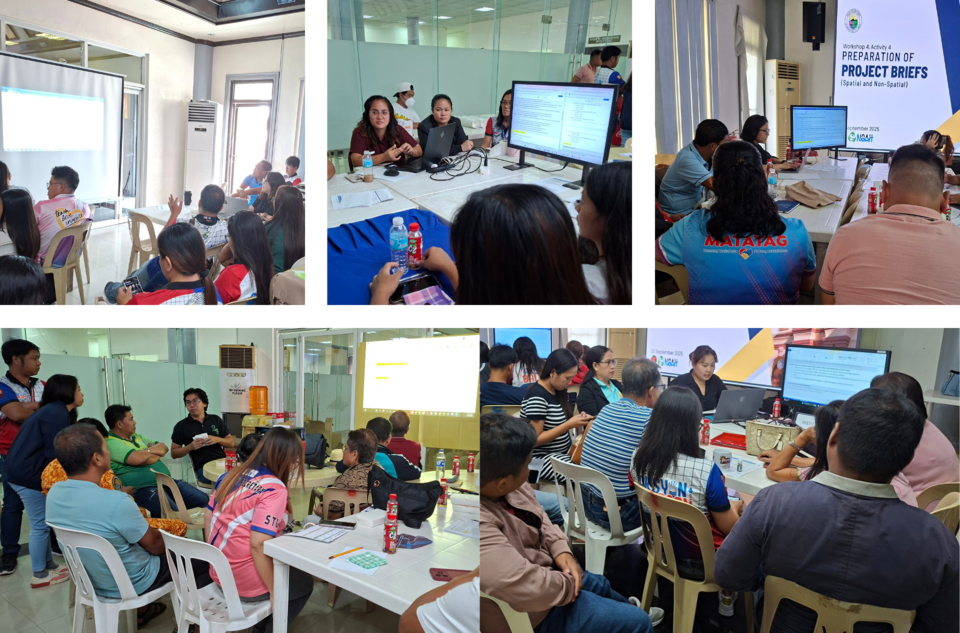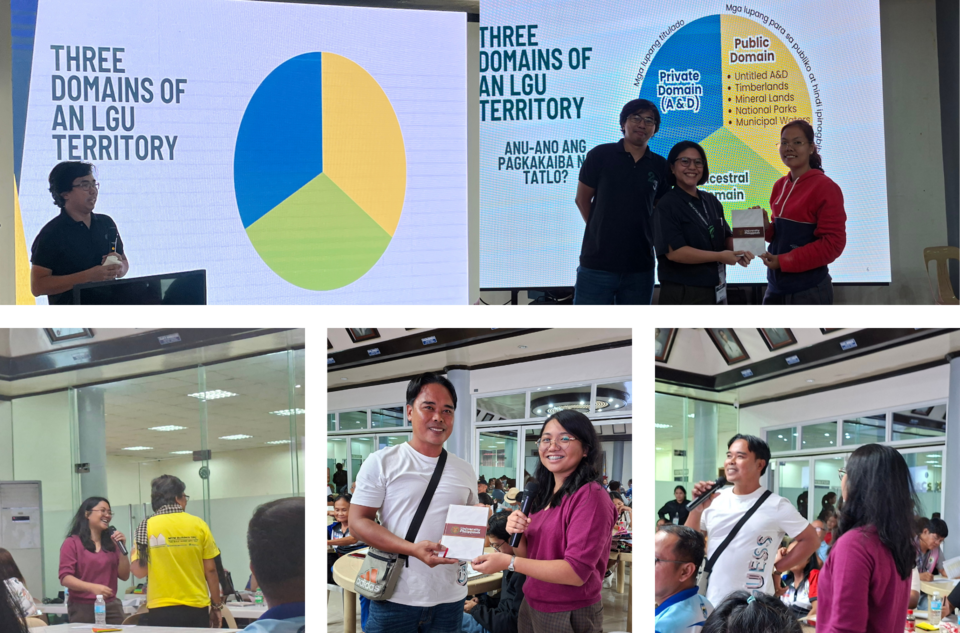By: Rysch Nae Subijano, RPF
The Municipality of Balaoan, with the UP Resilience Institute (UP RI), conducted a three-day Zoning Ordinance Amendment and PPA Prioritization Workshop from September 23 to 25, 2025, to strengthen local planning, land use management, and development prioritization (Figure 1). This workshop was undertaken as part of the ongoing partnership between the municipality and UPRI to update Balaoan’s land use and development plans.

Figure 1. (Left) The UP RI planning team with EnP. Charlie Balanon and staff from the Office of the Municipal Planning and Development Coordinator (OMPDC); (Right) Participants of the Zoning Ordinance Amendment and PPA Prioritization Workshop
Day 1: Land Use Validation and Zoning Fundamentals
The workshop opened with the presentation and validation of the proposed land use map, facilitated by UP RI’s sectoral coordinators (Figure 2), who discussed proposed land use changes across the municipality. Stakeholders actively shared feedback to ensure that the spatial strategy aligns with Balaoan’s priorities and ground realities.

Figure 2. Sectoral coordinators presenting the proposed land use changes during Lecture 1
EnP. Arge Louise Joy Esquivel followed with an in-depth discussion on the “Zoning Ordinance,” explaining its purpose, legal foundations, and vital role in local land use management (Figure 3). She traced the evolution of zoning from the traditional Euclidean model to more flexible, adaptive approaches and emphasized the role of land use zoning in climate change adaptation and disaster risk reduction (CCA-DRR).

Figure 3. EnP. Esquivel delivering her lecture on the Zoning Ordinance
EnP. Esquivel and Mr. Julius Obrique then proceeded to a zoning activity breakout session with representatives from the OMPDC, Office of the Municipal Assessor (OMAS), Municipal Disaster Risk Reduction and Management Office (MDRRMO), and Sangguniang Bayan (SB) (Figure 4). This activity primarily aimed to finalize the land use delineation in the Municipality of Balaoan.

Figure 4. EnP. Esquivel and Mr. Obrique facilitating the breakout session with representatives from several LGU offices
Simultaneously, in the main venue, Ms. April Dawn Tegelan discussed what and how structured PPAs are formulated (Figure 5). Her lecture focused on discussing how the Comprehensive Development Plan (CDP) transforms community vision into actionable PPAs. She also clarified the difference between services and PPAs, highlighting how structured PPAs form the backbone of effective local development.

Figure 5. Ms. Tegelan delivering her lecture on Structured PPAs

Figure 6. Sectoral coordinators guiding the participants in the discussion of Structured PPAs within their respective sectors
Day 2: Project Briefs and Communication Planning
Day 2 began with For. Rysch Nae Subijano’s lecture on Project Briefs, which explained how local governments can turn development goals into concrete, implementable interventions. She defined a project brief as a concise yet comprehensive document that consolidates all key project components. After the lecture, participants were tasked to work in sectoral groups to finalize the project briefs that were drafted for the municipality’s proposed PPAs (Figure 7).

Figure 7. Sectoral coordinators facilitating group discussions on project briefs for each sectoral project
Next, Ms. April Dawn Tegelan introduced the Communication Plan, emphasizing its role in promoting transparency and participation in the Comprehensive Land Use Plan (CLUP) process. She explained that an effective communication plan keeps communities informed, engaged, and empowered to understand and contribute to local development.
To wrap up the day, Ms. Marie Claire Mandar presented and validated the Visual Preference Survey (VPS) results, which captured community perspectives on Balaoan’s physical and visual environment. She emphasized that the VPS goes beyond aesthetics—it reflects the community’s identity, values, and aspirations.
Day 3: Project Prioritization and Integration
The final day focused on tools used by local governments to evaluate, prioritize, and harmonize development projects.
Engr. Kristian Audri Gabriel opened the series of lectures and activities with a discussion on the Urgency Matrix, a tool that determines which projects to implement first based on urgency, relevance, and impact (Figure 8). Participants were then tasked to assess each proposed project using prioritization forms.
EnP. Ella Danielle Santiaguel then discussed the Goals-Achievement Matrix (GAM), which measures how each project supports the municipality’s vision (Figure 8). She explained that the GAM promotes holistic and participatory evaluation of the proposed PPAs. After the discussion, participants were tasked to score each proposed project based on how well it contributes or contradicts Balaoan’s vision. The GAM used a scoring scale from +3 to –3, where +3 indicates a strong contribution and –3 indicates a strong contradiction of the proposed project to the municipality’s vision.

Figure 8. Engr. Kristian Audri Gabriel (Left), EnP. Ella Danielle Santiaguel (Middle), and Ms. Marie Claire Mandar (Right) delivering their lectures on the Urgency Matrix, GAM, and Conflict-Compatibility-Complementarity (CCC) Matrix.
The workshop concluded with Ms. Marie Claire Mandar’s lecture on the Conflict-Compatibility-Complementarity (CCC) Matrix, which helps planners and stakeholders examine how projects interact with one another (Figure 8). Through a plenary exercise using colored meta cards, participants identified whether projects were conflicting, compatible, or complementary, encouraging interactive discussion and collaborative decision-making (Figure 9).

Figure 9. Ms. Mandar and participants engaging in the plenary exercise for the CCC Matrix
Making Learning Fun and Engaging
Of course, a workshop wouldn’t be complete without a bit of fun. To keep participants energized and engaged, the facilitators held short quiz sessions. These interactive quizzes tested participants’ learning from the sessions in a lighthearted way, sparking friendly competition and laughter among the group. Two participants earned special prizes for their quick thinking and active participation, adding an enjoyable and memorable close to the productive three-day event (Figure 10).

Figure 10. Participants during short quiz sessions and the two winners recognized for their active participation
Building a Sustainable and Inclusive Balaoan
The three-day workshop strengthened Balaoan’s capacity to align its Comprehensive Land and Water Use Plan (CLWUP) and CDP through participatory validation, prioritization, and integration of development initiatives. With the guidance of UP Resilience Institute, the municipality continues to build a framework for sustainable, inclusive, and resilient local growth.
